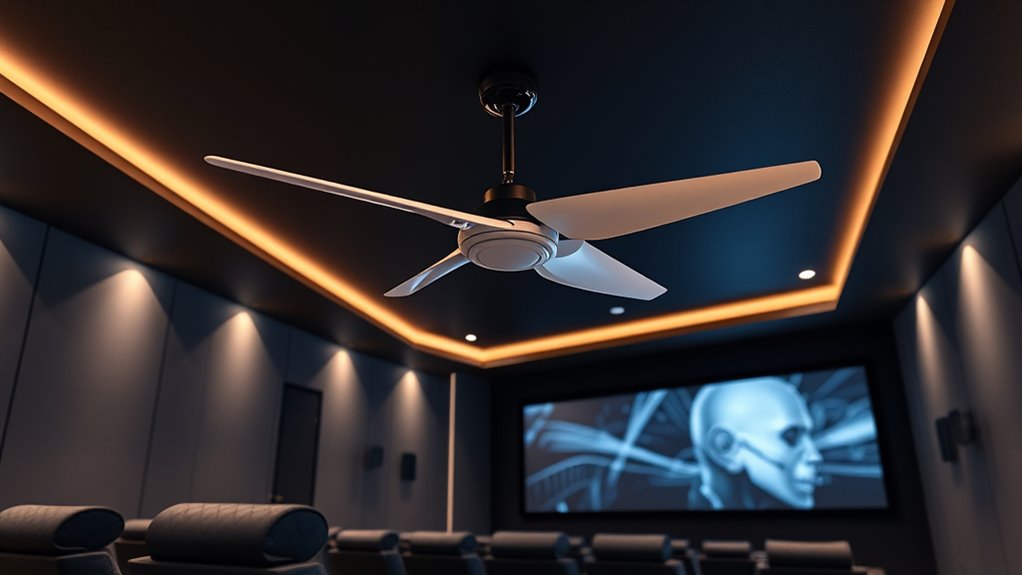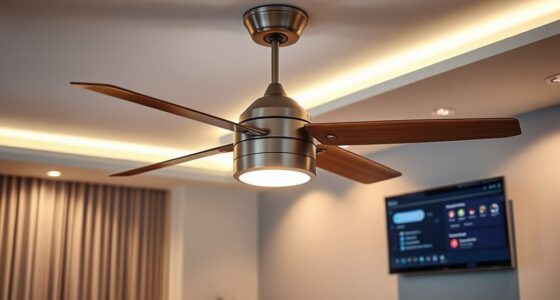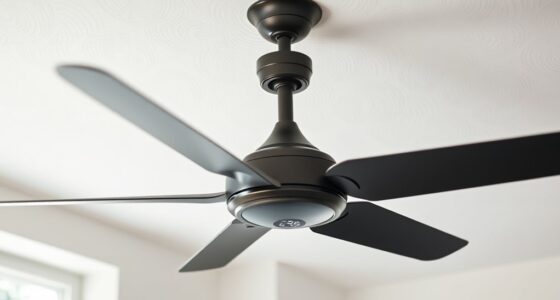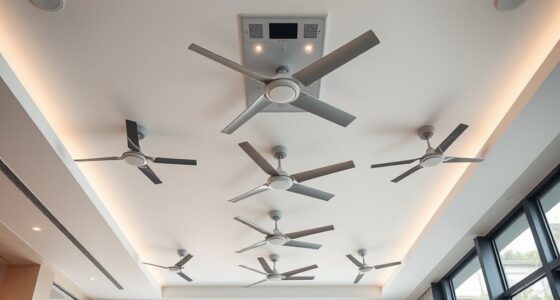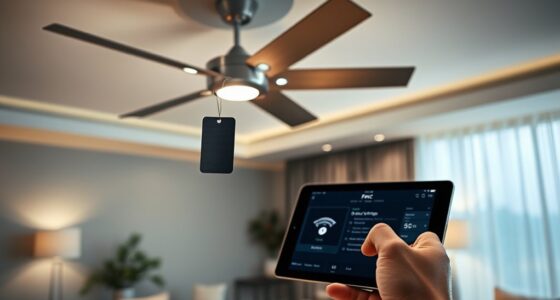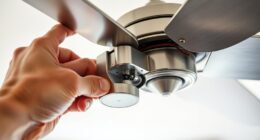Integrating smart ceiling fans with your home theater system allows you to synchronize airflow, lighting, and environmental adjustments for ideal comfort and immersion. Using compatible Wi-Fi, Zigbee, or Z-Wave-enabled fans, you can automate fan operation based on media playback, input detection, or ambient conditions. Setup involves connecting fans to your smart hub and configuring automation routines, often via home automation apps. Effective integration requires careful wiring, selecting quiet models, and establishing reliable communication—discover how these elements combine for a seamless media environment.
Key Takeaways
- Integrate smart ceiling fans with home automation platforms for synchronized control during media playback.
- Use Wi-Fi, Zigbee, or Z-Wave protocols to connect fans with compatible home theater systems.
- Automate fan operation based on media activity, ambient temperature, or specific scenes for enhanced comfort.
- Select quiet, motorized fans to prevent audio interference and ensure an immersive viewing experience.
- Customize routines and voice commands to manually adjust airflow and lighting during media sessions.
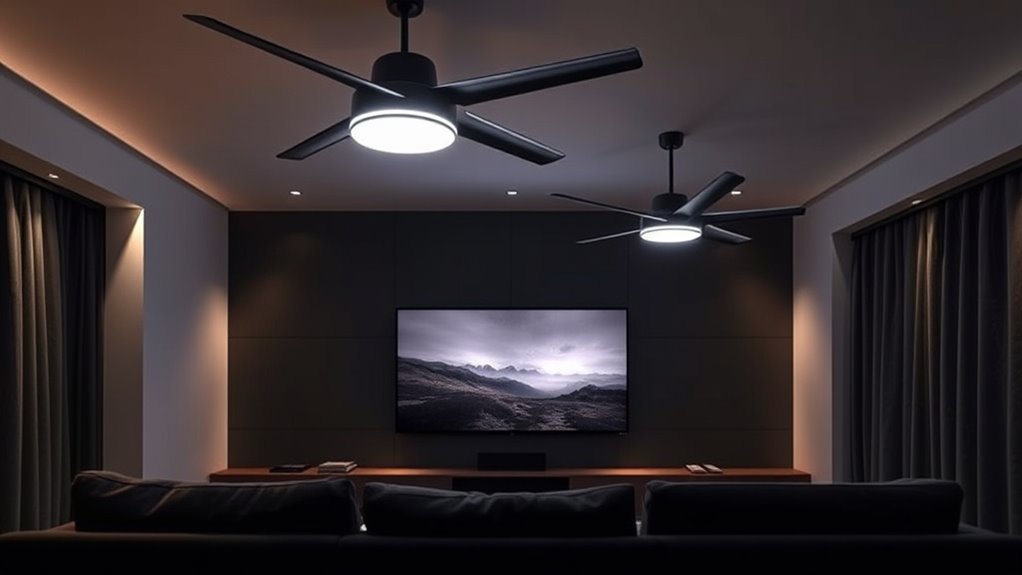
Integrating smart ceiling fans with home theater systems can considerably enhance comfort and energy efficiency during media consumption. This integration allows you to synchronize fan operation with audiovisual events, optimizing environmental conditions based on activity and ambient temperature. By linking the smart fan’s control system with your home automation platform, such as Google Home or Amazon Alexa, you create a seamless, responsive environment that adjusts airflow dynamically. For instance, during intense action scenes or heated discussions, the system can increase fan speed to improve air circulation and comfort without manual intervention. Conversely, during quieter moments, it can reduce airflow to minimize noise and distraction.
Smart ceiling fans can sync with your home theater for optimal comfort and energy efficiency during media use.
From a technical perspective, the key to effective integration lies in the communication protocols and control interfaces. Most smart ceiling fans support Wi-Fi, Zigbee, or Z-Wave connectivity, enabling them to interface with smart hubs or controllers embedded within your home theater setup. You’ll need compatible hardware and software to establish a reliable link, such as a smart home hub that consolidates device management. Once connected, custom routines and triggers can be programmed. For example, when your media system detects playback begins or a specific input, it can activate preset fan speeds aligned with your comfort preferences. You can also incorporate environmental sensors, such as temperature or humidity detectors, that feed data into the automation system, prompting real-time adjustments to the fan’s operation. This guarantees ideal comfort regardless of external conditions.
Furthermore, the integration process often involves configuring the control parameters within your home automation app. You’ll specify conditions under which the fan operates at certain speeds, times of day for scheduled adjustments, and even voice commands for manual override. These configurations should consider the acoustics of your media room; selecting fans with quiet motors and minimal blade noise is essential to prevent interference with audio clarity. Additionally, some advanced models include features like dimmable integrated lighting, which can be synchronized with your home theater’s lighting scenes for immersive ambiance. Proper wiring and power management are vital, especially if you’re retrofitting existing ceiling structures; confirm your setup complies with electrical standards to prevent safety issues.
Incorporating curiosity-driven features into your smart home can further enhance your media experience by enabling you to explore new functionalities and customizations. Ultimately, integrating smart ceiling fans with your home theater system not only elevates your viewing experience but also introduces precise environmental control that conserves energy. By leveraging automation, sensor feedback, and voice commands, you create an adaptive environment that responds intelligently to your media activities. This fusion of climate control and entertainment technology demands careful planning, compatible hardware, and meticulous configuration, but the result is a highly customized, efficient, and comfortable home theater environment.
Frequently Asked Questions
Can Smart Ceiling Fans Be Integrated With Voice-Controlled Home Automation Systems?
Yes, smart ceiling fans can be integrated with voice-controlled home automation systems. You’ll need compatible smart fans and a hub like Amazon Alexa, Google Assistant, or Apple HomeKit. Connect the fan via its app, then link it to your automation system. This setup allows you to control fan speed, turn it on/off, and schedule operations through voice commands, providing seamless, hands-free climate management within your smart home ecosystem.
Are There Specific Smart Fan Models Compatible With All Home Theater Setups?
You can find smart fans like the Haiku L Series or Hunter Symphony compatible with various home theater setups. These models feature Wi-Fi or Zigbee integration, allowing seamless control through apps or voice commands. Confirm your hub supports the fan’s protocol and check compatibility with your existing automation system. Look for models with adjustable fan speeds, dimmable integrated lighting, and customizable schedules to optimize comfort without disrupting your theater experience.
How Do Smart Ceiling Fans Impact Audio Quality During Movie Playback?
Smart ceiling fans can create minor airflow noise, which might subtly interfere with audio clarity during movie playback. High-quality fans with quiet motors and sound-dampening features substantially minimize this impact. To enhance audio, position fans away from speakers and use soundproofing techniques if necessary. Regular maintenance guarantees peak operation. Overall, choosing a fan with low operational noise helps preserve immersive sound quality during your home theater experience.
What Safety Precautions Are Necessary When Installing Smart Fans Near Home Theater Equipment?
Imagine installing a smart ceiling fan near your home theater; you should turn off the fan and disconnect power during installation. Guarantee the fan’s wiring is properly grounded to prevent electrical interference. Keep fan blades at least three feet from audio equipment and cables to avoid vibrations or electromagnetic interference. Use shielded wiring where possible, and follow manufacturer instructions meticulously to minimize risks of damage or interference with sensitive home theater components.
Do Smart Ceiling Fans Require Special Wiring or Electrical Modifications?
Smart ceiling fans generally don’t require special wiring or electrical modifications if your existing circuit can handle their power needs. You should verify that your circuit’s amperage matches the fan’s specifications, typically 15 or 20 amps. If you’re installing multiple devices or a new circuit, consult an electrician to confirm proper wiring and grounding. Most smart fans connect via standard wiring and Wi-Fi, making installation straightforward with basic electrical knowledge.
Conclusion
Think of your smart ceiling fan as the conductor in your home theater symphony, seamlessly coordinating airflow and system performance. When integrated properly, it optimizes ambient conditions, reduces energy waste, and enhances your viewing experience. Just as a conductor ensures each instrument plays in harmony, a smart fan synchronizes with your entertainment system, maintaining ideal temperatures and air circulation. Mastering this integration transforms your space into a finely tuned environment, elevating comfort and technological synergy.
